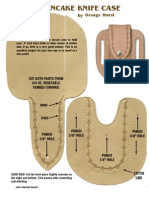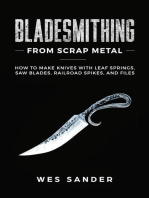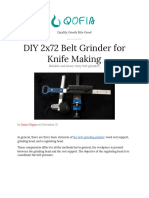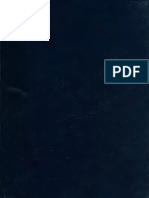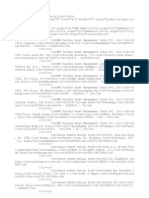Damascus Notes
Damascus Notes
Uploaded by
uchoaCopyright:
Available Formats
Damascus Notes
Damascus Notes
Uploaded by
uchoaCopyright
Available Formats
Share this document
Did you find this document useful?
Is this content inappropriate?
Copyright:
Available Formats
Damascus Notes
Damascus Notes
Uploaded by
uchoaCopyright:
Available Formats
Notes on Pattern Welded Steel
By Matt Walker
I want to give here an over view of how I make Damascus steel along with some opinions and ideas. The first thing I want to say is this is what works in my shop for me. Making Damascus is almost a faith based pursuit and some people may disagree with my methods. If you talk with several people that are serious about this stuff you will see why I say it is somewhat like religion. We are all trying to get to the same place but often value different formalities in the practice of getting there. So learn everything you can and use what works for you. No one is born knowing this stuff. I will try to give credit at the end to some that I have learned from and mention resources I value.
First lets talk about materials. Most steels and even wrought iron can be welded and manipulated to create patterns. If you put wrought, mild steel or nickel in the original billet you run the risk of having layers that wont harden or the lower carbon layers robbing from the higher carbon layers possibly resulting in a blade that wont respond properly to heat treatment. In some cases, like a tomahawk, where a tool steel bit will be used softer layers can be acceptable because just the working edge needs to be hardened. I use nickel in my bars only when my informed customers ask for it. Nickel really does make a piece pretty and after all whoever is paying gets to choose what they want in my business. Another thing to think about is that some steels arent compatible in a billet. By this I mean that you run the risk of having a piece tear its self apart during heat treat due to radically different alloying elements in the steel causing differential rates of expansion and contraction under extremely fast temperature changes. My recommendation for the best materials are 1084 and 15N20. This combination provides everything I want for a piece that I can confidently provide to others. The 1084 will be very dark and contrast nicely with the 15N20 which will be bright. These steels are very similar in composition and perform well in heat treat and make an outstanding blade. I also believe they stand up better to mismanagement (time and temperature extremes) than some other mixes might. Other things that are interesting to work with are wire rope and chainsaw chain. Both can provide some very cool patterns. While wire rope welds up easy both it and chainsaw chain are hard to complete without small flaws. I like the patterns that can be created with both these materials even if it is mostly a novelty. This piece is
saw chain welded in a can with powdered steel and is 100% flaw free. More on cans and powder later.
Now lets talk about technique. Billy Phelps told me once to forge weld requires 2400 degrees and 800 pounds per square inch. I think it would take lab conditions to prove this but it seems reasonable to me. I do know higher carbon tool steels will weld at slightly lower temperatures than mild steel and wrought needs to be screaming white hot to weld or even to forge successfully. A coal forge will certainly reach the required temperature and I use it often for welding certain general blacksmithing projects. But for pattern welded blade steel a good blown propane fired forge would be hard to beat. I know some use atmospheric forges with much success also and I mean to build one in the near future with some special design features and experiment in the interest of fuel economy. But over many years I have found the blown forge to give me total control over the the most critical concerns: atmosphere, temperature and time. So the big question is how do I know when its ready? The first thing I would say, it is essential you must be able to see the work. Seeing the work requires some type of eye protection which is a whole subject to itself. I use a shade 3 welding lens. There are other products available. Find what works for you but use some kind of eye protection when welding even in coal. I believe if you can see the work it can be managed better. As for what to look for its a little hard to describe and experience
is the best teacher here as you learn your forge and the lighting conditions in your shop and what the look is with whatever eye protection you choose. For me when the flux is violently active and the billet appears the same color as the inside of the forge I wait a few more minutes so that the inside of the billet can catch up. Then apply the pressure. Its a feel thing that comes after making a few pieces that fail. It certainly wont weld up good if its too cool but long soak times at welding temperatures arent good for the steel either. Although plastic deformation and thermal cycling can repair some of the grain damage done by overheating a piece with bad welds isnt useable. So managing the compromise is part of the feel thing I mentioned. Here is what I believe about flux. Many people use 20 Mule Team Borax out of the box. I cant recommend that because most of it quickly hits the floor or the bottom of the forge. Anhydrous borax is a much better alternative and all things considered may be more economical. With anhydrous more flux stays on the work and seems to penetrate better so less is wasted. There are other things that can be beneficial in flux. Here is a recipe for Super Flux that I share with permission from Chuck Robinson of Picayune, MS 15 Parts Borax, 6 Parts Boric Acid, 3 Parts Iron Oxide and 2 Parts Fluorspar. I like this stuff a lot. I have welded stainless to carbon, in atmosphere, with this flux, which is something some say cant be done. Be warned fluorspar isnt healthy and only use it with good ventilation or proper breathing protection. Some say too much flux is bad. I like to use a lot of flux. Consider the job of flux is to remove oxides and trash. I like to see the flux dripping off the billet taking the unwanted stuff with it. For me the proper amount is what stays
on the piece at welding temperature. The time to introduce the flux is just before color shows in the work. A low red will melt the flux and that is when it starts to do its work. Making the weld basically requires that enough pressure be applied to the stack of individual pieces to force out the flux and molten scale so that the steel surfaces are in contact inside the welding temperature range. There are many ways to accomplish this. While a hand hammer will certainly work a power hammer can hit it many more times with the amount of force I determine while at temperature. Extreme hard blows arent what is called for when making the weld. But, lots of moderate well placed blows are, and the faster you can overlap the last one with the next one the better. Whether power or hand hammer the first series of overlapping blows should cover the center of the billet and the next series down the side overlapping both the last blow with the next one but also overlapping the previous series of center blows. Power hammer dies should not be flat for this work but need a small amount of crown in the center, to help push the trash out and not help to trap it in. Ive found through experience that a forging press is an even better (cleaner, faster and more consistent) way to set the weld. I think the press is better due to forging dynamics that are beyond the scope of this paper. After the weld is set there is the problem of drawing out in preparation for a fold or a stack. For me that is a combination of the press and the power hammer. The press being the brute force tool and the power hammer being the finesse tool. Building up layers can be accomplished either by folding to double each time or drawing way out and cutting the bar into multiple pieces and re-welding. I use both methods but typically draw out enough to cut 5 or 6 pieces then re-stack the
billet for another welding cycle, I sometimes do that again. Then sometimes will bifold or trifold to reach a predetermined layer count. Some patterns look better in higher layers and some in lower and some customers know a range they want the piece to have. Again, the guy that is buying has the correct idea. Also on the subject of drawing out I have a McDonald Rolling Mill that is used mostly for final forging steps on a piece. The mill is the most efficient tool for working to a desired thickness and leaves a cleaner more consistent surface than my other forging tools. Many people forge Damascus by hand but I would never recommend it due to potential damage to your body and frustration levels. Just managing a moderately sized billet against the leverage of a long handle (necessary to isolate from the heat) can really hurt your elbows in a short time. I beat this problem by using a device called a tool balancer to carry the weight of the workpiece. The tool balancer was recommended by a friend (Charlie Murray) and may be the best single thing I have found to help in production Damascus. When you are doing this for many hours a day several days in a row anything that makes it physically easier allows you to work longer, faster and safer. After the preferred layer count is reached something needs to be done to make a pattern happen. Otherwise you will just have a straight pattern if everything went as it should up to this point.
Patterns are usually created by manipulating the steel mechanically or by stock removal. Twisting is an example of mechanical manipulation. Drilling holes or milling grooves are examples of how stock removal followed by forging can expose layers to cause a pattern. Different dies can be used to make impressions in the surface then when the raised areas are milled away a pattern appears in the exposed layers. Expect to loose up to two-thirds of the material you started with in grinding out these stock removal developed patterns. Remember the last forging cycle before pattern development needs to leave a piece 3 times as thick as what you want to end with. You will be drilling or otherwise cutting one-third the thickness from each side and forging to the middle or deforming one-third the thickness from both sides and grinding to the center one-third. See the references on the last page for more on pattern development. Patterns are unlimited and I dont type fast enough to go much deeper here.
Whatever pattern is developed wont show up much until the piece is etched. For etching I use Ferric Chloride. Ferric Chloride is the best and safest etchant for the metals I use. Etching will give a good idea of what you have created in all your hours of hot dirty work but the pattern wont really pop until the piece is properly heat treated and finished. If you have never done this before odds are huge you will have some problems, there are many, but can be beat. So lets look at a few of the more common ones and what causes them. Inclusions are usually small and are something that was trapped between the layers sometime during the welding process. Most likely they are scale or pockets of flux that werent driven out due to poor technique when making the weld or they could be dirt from leaving grinding dust between layers. It doesnt matter what they are but what matters is that they ruin the look of the piece and the way to avoid having them is to be fanatical about your weld surfaces. Weld surfaces must be clean and either dead flat or very slightly convex never even slightly concave and free of divots. I grind and wipe clean my material before each weld cycle. I know many feel this is a waste of time and labor but I almost never have an inclusion. Furnishing material for others I cant afford to have bad metal out there. Even if I were making steel for my own use I still would spend the extra time to keep everything clean because who wants to get almost finished grinding a blade and have an ugly booger show up. This involves some pretty heavy grinding between forging cycles and welding cycles. And the work would be much faster if I just cut and folded depending on the flux to work miracles. But I think it is worth it after all you are doing the whole exercise to create something special not something special except for that small black spot
near the tip. I think etching a little deeper to blend a booger is unacceptable. Another common event is having blisters pop up on the surface of the billet. I think these come from leaving low spots on the surface of a layer. When the weld happens around the low spot whatever air or flux is in the low spot is trapped then later when temps are high there is enough boiling or expansion to cause a blister. Sometimes blisters happen when using thin material in the initial stack and the only way I know to avoid that is to put thicker layers on the outside and clamp the stack really tight before placing the arc welds that we use to hold everything together until the first forge weld is completed. To deal with them after the fact, some people center punch and flux and go back for another welding cycle. When I had a few early on I found it best to grind them completely out. Either solution can compromise your final pattern a little. Another good thing about heavy grinding after the forging cycle and drawing way out is sometimes there can be blisters that you fail to notice as a dark spot on the metal during forging or that dont raise up. If a spot like this was missed earlier in the process during heavy grinding it will glow red because it is so much thinner and is insulated from the surrounding material. Much better to deal with it then than putting it back in the center of a billet during a fold or re-stack. Another common problem beginners have is simply bad welds. Bad welds can be the result of too low temperatures when trying to weld, missing a place when setting the weld (hand hammer or power the blows need to overlap), flux not reaching an area, starting a weld sequence when the outside is up to temperature but the inside of the billet hasnt reached a welding heat yet
or again just working dirty. Normally the billet is worked square. If you ever have a question about how good your welds are turn the billet on the diamond and work it some. If the welds are good the piece should forge like a solid bar of steel. If they arent it will shear apart. You want to find poor welds as soon as possible and deal with them or scrap the piece before more time is invested. A less common method of creating a pattern welded piece is working with pieces of steel and or powdered metal enclosed in a steel container. Some of the advantages are: Fewer limits on what can be done, allows for working with odd shapes, powder and small pieces and if done correctly, perfect solid welds. The main disadvantages Ive found are: the extra work in setting up the can correctly, long soak times mean extra fuel used, powder is expensive and hard to find, removing the sacrificial container can be labor intensive and often the piece requires accordion cutting which is also labor and time intensive. The best thing about working in a can is that things can be done that arent possible with normal methods.
If you got this far Thanks. My intended two or three pages has turned into a monster. If you have the tools and dont mind hot, hard, dirty work try pattern welding. You might become as interested as I am. Work hot, keep your work clean and try new things. Matt Walker .. http://www.matthewdwalker.com/
Resources and People I Need To Say Thanks To: In no particular order,
Roy Carter, John Young and Harry Noel---These guys bought everything I made (good or bad) early on and encouraged me to push my skill limits. These guys can make a knife from anything that will grind and harden. Steve Vanderkolff---Steve took a chance and used my steel several years ago, as a result my work has enjoyed international exposure.. http://www.vanderkolffknives.com/
Jim Prill---Great sounding board for new ideas always ready to help with an open mind. Len Landrum---If you spend any time around Len you cant help but learn about steel. http://www.landrumknives.com/ Darren Ellis--Gas forge resource.. http://home.comcast.net/~eellis2/EllisCustomKnifeworks/index.htm l Ron Bowi Clayborn- Encyclopedia Damascus. Always willing to share knowledge. http://thundermountainforge.com/ Jim Hirsoulas---Without his three books I would have been lost starting out....http://www.atar.com/old/ Ed Caffery---I wish I had seen his videos when I was first starting. Packed with valuable information that will help new or experienced Damascus makers....http://www.caffreyknives.net/index.html Knife network---What a great resource, full of knowledgeable people ready to help....http://www.knifenetwork.com/forum/index.php Here is a random link to a tool balancer seller where you can see photos and get an idea how they work. If you plan to make more than the occasional piece of Damascus you need one. There are usually several on E-bay. http://www.springbalancers.com/ Mick Maxen---Go to British Blades and study everything he posts. I admire his work.
You might also like
- Treadle Hammer PlansDocument18 pagesTreadle Hammer PlansKurt Deen100% (7)
- Gas Burners For Forges Furnaces and Kilns-Michael PorterDocument208 pagesGas Burners For Forges Furnaces and Kilns-Michael PorterEsmeralda Palatnic Ampuero95% (22)
- Goddard Wayne - Wayne Goddard S $50 Knife ShopDocument160 pagesGoddard Wayne - Wayne Goddard S $50 Knife ShopederupfNo ratings yet
- Power HammerDocument18 pagesPower Hammerbearyuyu100% (3)
- River Valley Civilizations DBQDocument14 pagesRiver Valley Civilizations DBQapi-327647329No ratings yet
- Brautigan, Richard - Willard and His Bowling Trophies, A Perverse MysteryDocument63 pagesBrautigan, Richard - Willard and His Bowling Trophies, A Perverse Mysterystarry01482100% (1)
- Knife Making 101 TextDocument19 pagesKnife Making 101 Textrace egrNo ratings yet
- Rust Bluing TutorialDocument9 pagesRust Bluing TutorialStefan Badica100% (1)
- Simple Air HammerDocument3 pagesSimple Air Hammerregt_200050% (4)
- How To Forge Tapers by Alec SteeleDocument15 pagesHow To Forge Tapers by Alec SteeleDušan Rodić100% (2)
- Wheellock PlansDocument59 pagesWheellock PlansPuturrú De Fuá100% (2)
- Fabricating A FlypressDocument4 pagesFabricating A FlypressNebojsa IlijevicNo ratings yet
- Pancake Knife SheathDocument2 pagesPancake Knife SheathFernando Filus Pierin100% (1)
- Microsoft PowerPointDocument11 pagesMicrosoft PowerPointjimNo ratings yet
- Mercedes Code DescriptionsDocument113 pagesMercedes Code Descriptionssilviu mihaiNo ratings yet
- Kircher (Tammearu) - Musica PatheticaDocument113 pagesKircher (Tammearu) - Musica PatheticaAntonio G100% (1)
- As Published Knives IllustrDocument6 pagesAs Published Knives IllustrPista BalogNo ratings yet
- A Home-Grown FoundryDocument12 pagesA Home-Grown Foundryjraju1974100% (4)
- 101 Bladesmithing Mistakes: Knife Making Mistakes That Ruin Your Knives and How to Avoid ThemFrom Everand101 Bladesmithing Mistakes: Knife Making Mistakes That Ruin Your Knives and How to Avoid ThemRating: 5 out of 5 stars5/5 (1)
- Bladesmithing From Scrap Metal: How to Make Knives With Leaf Springs, Saw Blades, Railroad Spikes, and FilesFrom EverandBladesmithing From Scrap Metal: How to Make Knives With Leaf Springs, Saw Blades, Railroad Spikes, and FilesRating: 4.5 out of 5 stars4.5/5 (3)
- Bladesmithing: A Definitive Guide Towards Bladesmithing Mastery: Knife Making Mastery, #1From EverandBladesmithing: A Definitive Guide Towards Bladesmithing Mastery: Knife Making Mastery, #1Rating: 5 out of 5 stars5/5 (1)
- Intermediate Guide to Bladesmithing: Make Knives, Swords and Forge Damascus: Knife Making Mastery, #2From EverandIntermediate Guide to Bladesmithing: Make Knives, Swords and Forge Damascus: Knife Making Mastery, #2Rating: 4.5 out of 5 stars4.5/5 (2)
- Bladesmithing: Bladesmithing for Beginners: Make Your First Knife in 7 StepsFrom EverandBladesmithing: Bladesmithing for Beginners: Make Your First Knife in 7 StepsRating: 5 out of 5 stars5/5 (1)
- Bladesmithing: Advanced Guide to Bladesmithing: Forge Pattern Welded Damascus Swords, Japanese Blades, and Make Sword Scabbards: Knife Making Mastery, #3From EverandBladesmithing: Advanced Guide to Bladesmithing: Forge Pattern Welded Damascus Swords, Japanese Blades, and Make Sword Scabbards: Knife Making Mastery, #3Rating: 5 out of 5 stars5/5 (1)
- Bladesmithing: 101 Bladesmithing FAQ: Answers to Your Burning Knifemaking Questions About Forging, Stock Removal, Tools, and Heat TreatmentFrom EverandBladesmithing: 101 Bladesmithing FAQ: Answers to Your Burning Knifemaking Questions About Forging, Stock Removal, Tools, and Heat TreatmentNo ratings yet
- Bladesmithing: A Step-by-Step Guide to Forging Your Own Knives for BeginnersFrom EverandBladesmithing: A Step-by-Step Guide to Forging Your Own Knives for BeginnersNo ratings yet
- Bladesmithing: Beginner + Intermediate Guide to Bladesmithing: Bladesmithing Compendium for Beginners and Intermediate Level Knife MakersFrom EverandBladesmithing: Beginner + Intermediate Guide to Bladesmithing: Bladesmithing Compendium for Beginners and Intermediate Level Knife MakersRating: 4 out of 5 stars4/5 (1)
- DIY 2x72 Belt Grinder For Knife MakingDocument4 pagesDIY 2x72 Belt Grinder For Knife MakingJamespagan0% (1)
- Case HardeningDocument6 pagesCase Hardeningabhi16100% (2)
- Building A Ceramic KnifeDocument49 pagesBuilding A Ceramic KnifeztmpNo ratings yet
- Butterfly KnifeDocument5 pagesButterfly KnifeYousef Al HessiNo ratings yet
- Blacksmith Student NotesDocument111 pagesBlacksmith Student NotesGh-reza Shaban100% (1)
- Wootz Crucible Steel: Mel-Siruvalur Site in South India (Sharada Srinivasan 1994)Document11 pagesWootz Crucible Steel: Mel-Siruvalur Site in South India (Sharada Srinivasan 1994)Srini KalyanaramanNo ratings yet
- Ballardarms PortfolioDocument20 pagesBallardarms PortfolioHeikG002No ratings yet
- Blade GrindingDocument33 pagesBlade GrindingbujarnNo ratings yet
- Steel: It's Selection, Annealing, Hardening and TemperingDocument440 pagesSteel: It's Selection, Annealing, Hardening and TemperingArtisan Ideas83% (6)
- Damascus Barrel MythDocument6 pagesDamascus Barrel MythHerman Karl0% (1)
- Power Hammer ProcedureDocument18 pagesPower Hammer ProcedureFrancois Córdova100% (1)
- British Big BoresDocument5 pagesBritish Big BoresJohn McClellandNo ratings yet
- Mongo Burner For Gas ForgeDocument1 pageMongo Burner For Gas ForgeJacobParkerNo ratings yet
- Restoring An Old Gun From The Ground Up (Literally) - Montana Sporting JournalDocument58 pagesRestoring An Old Gun From The Ground Up (Literally) - Montana Sporting JournalFrank Meeker100% (1)
- How To Build A Gas Forge BurnerDocument10 pagesHow To Build A Gas Forge BurnerKevin Guy0% (1)
- Wooden Knife Handle and SheathDocument10 pagesWooden Knife Handle and SheathMehmet Emre Bastopcu100% (2)
- Damascus SteelDocument7 pagesDamascus SteelMichael MichaelNo ratings yet
- Making Bullet MoldsDocument66 pagesMaking Bullet MoldsSofia Norberg100% (2)
- Make A Small Blacksmith S ForgeDocument9 pagesMake A Small Blacksmith S Forgemarius_danila8736No ratings yet
- Quick Reference Guide To Heat TreatingDocument1 pageQuick Reference Guide To Heat TreatingArtisan IdeasNo ratings yet
- Blacksmithing Tools: "By Hammer and Hand All Arts Do Stand."Document1 pageBlacksmithing Tools: "By Hammer and Hand All Arts Do Stand."pizzolattoNo ratings yet
- Bolt, Nut and Rivet Forging by Douglas T. HamiltonDocument52 pagesBolt, Nut and Rivet Forging by Douglas T. HamiltonArtisan Ideas100% (1)
- Folding Blade Knife With Spring Assisted Pivoting Feature (US Patent 6959494)Document13 pagesFolding Blade Knife With Spring Assisted Pivoting Feature (US Patent 6959494)PriorSmart0% (1)
- Blacksmith Fundamentals PDFDocument47 pagesBlacksmith Fundamentals PDFHumberto AraujoNo ratings yet
- Damascus SteelDocument8 pagesDamascus Steelmuhammad85No ratings yet
- Damascus SteelDocument2 pagesDamascus SteelmaxfischNo ratings yet
- Metal Sand CastingDocument22 pagesMetal Sand CastingCharo Mel Tablo100% (1)
- Em 862 Blacksmith PracticeDocument48 pagesEm 862 Blacksmith PracticeIsdat AfamasNo ratings yet
- Build A Gas Forge by Wayne CoeDocument3 pagesBuild A Gas Forge by Wayne CoeElias MuñozNo ratings yet
- S. L. Terrill Knives: Public Knife DesignsDocument2 pagesS. L. Terrill Knives: Public Knife DesignsNancy Carina RabottiniNo ratings yet
- 1911 Front Sight Dovetail Cut DimensionsDocument1 page1911 Front Sight Dovetail Cut DimensionsJorge PiresNo ratings yet
- Blacksmithing 101 - How To Make A Forge and Start Hammering Metal - Popular MechanicsDocument6 pagesBlacksmithing 101 - How To Make A Forge and Start Hammering Metal - Popular MechanicsByram JNo ratings yet
- 34 Knife DesignDocument10 pages34 Knife Designsalenka71100% (1)
- Damascus SteelDocument15 pagesDamascus SteelKonstantinos TheodosiadisNo ratings yet
- Hardening and TemperingDocument56 pagesHardening and TemperingArtisan Ideas100% (4)
- Blackpowder RiflesDocument40 pagesBlackpowder RiflesRichard Harig100% (1)
- Ivermectina No Tratamento Da DengueDocument18 pagesIvermectina No Tratamento Da DengueuchoaNo ratings yet
- Nasal Feeding Tubes Are Associated With Fewer AdveDocument7 pagesNasal Feeding Tubes Are Associated With Fewer AdveuchoaNo ratings yet
- POMA Paper PDFDocument22 pagesPOMA Paper PDFuchoaNo ratings yet
- Whole PDFDocument417 pagesWhole PDFuchoaNo ratings yet
- Play Time: The 2009 Taylor LineDocument56 pagesPlay Time: The 2009 Taylor Lineuchoa100% (1)
- Lowrider 2010-12 PDFDocument104 pagesLowrider 2010-12 PDFjonathan chenNo ratings yet
- Rezultate OLE Judet - Xls NOUDocument18 pagesRezultate OLE Judet - Xls NOUsteproNo ratings yet
- BAS GEOMAP 2, Sheet 4 - Geological Map of South GeorgiaDocument1 pageBAS GEOMAP 2, Sheet 4 - Geological Map of South GeorgiaRodrigo Giesta FigueiredoNo ratings yet
- Yourshepway Sellindge 10.03.10Document1 pageYourshepway Sellindge 10.03.10James AlexandreNo ratings yet
- Bulletin 161011Document1 pageBulletin 161011StJosephsAnsdellNo ratings yet
- Blowing in The Wind Key of CDocument4 pagesBlowing in The Wind Key of Cdoboing0% (1)
- Report On Hyder Aliyev CenterDocument34 pagesReport On Hyder Aliyev Centershubasri tirunagariNo ratings yet
- Surah YaasinDocument13 pagesSurah YaasinaqilhadNo ratings yet
- Worksheet InggrisDocument3 pagesWorksheet InggrisFaizal AldiNo ratings yet
- Country Dry SinkDocument4 pagesCountry Dry SinkjcpolicarpiNo ratings yet
- Declining Participation in Christian YouthDocument6 pagesDeclining Participation in Christian YouthSharene EribalNo ratings yet
- Std6 English Revision 2018Document3 pagesStd6 English Revision 2018Shailaja UdtewarNo ratings yet
- FocusonAnimation PDFDocument68 pagesFocusonAnimation PDFttap79No ratings yet
- Components: 36 Playing CardsDocument2 pagesComponents: 36 Playing CardsJohnathan HemenwayNo ratings yet
- 8 Ways Art Benefits Our Everyday LivesDocument2 pages8 Ways Art Benefits Our Everyday LivesColeen gaboyNo ratings yet
- Maj7 Chord MelodiesDocument2 pagesMaj7 Chord MelodiesAttoNo ratings yet
- Deleuze, Gilles. - Cours Du 22 Octobre 1985.: FoucaultDocument23 pagesDeleuze, Gilles. - Cours Du 22 Octobre 1985.: FoucaultmarxbertNo ratings yet
- Business Letters FormatsDocument18 pagesBusiness Letters FormatsFurrhaFurrhaNo ratings yet
- English ProjectDocument8 pagesEnglish ProjectFran Castillejos IbáñezNo ratings yet
- The Black Saint and The Sinner LadyDocument2 pagesThe Black Saint and The Sinner LadyM. Korhonen100% (1)
- Lecture 5 - Doris LessingDocument6 pagesLecture 5 - Doris LessingBorisNo ratings yet
- Zentangle Animal d1Document9 pagesZentangle Animal d1api-457920671No ratings yet
- Agapáo (Agápe) and Phileo. The Correct Translation Regarding The 1 Corinthians Passage IsDocument12 pagesAgapáo (Agápe) and Phileo. The Correct Translation Regarding The 1 Corinthians Passage Ishiensh02No ratings yet
- Addresses of AMC Branches 160711Document40 pagesAddresses of AMC Branches 160711kimsrNo ratings yet
- Atget MomaDocument113 pagesAtget MomaHieronymus BoschNo ratings yet












